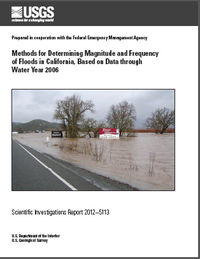Methods for estimating the magnitude and frequency of floods in California that are not substantially affected by regulation or diversions have been updated. Annual peak-flow data through water year 2006 were analyzed for 771 streamflow-gaging stations (streamgages) in California having 10 or more years of data. Flood-frequency estimates were computed for the streamgages by using the expected moments algorithm to fit a Pearson Type III distribution to logarithms of annual peak flows for each streamgage. Low-outlier and historic information were incorporated into the flood-frequency analysis, and a generalized Grubbs-Beck test was used to detect multiple potentially influential low outliers. Special methods for fitting the distribution were developed for streamgages in the desert region in southeastern California. Additionally, basin characteristics for the streamgages were computed by using a geographical information system.
Regional regression analysis, using generalized least squares regression, was used to develop a set of equations for estimating flows with 50-, 20-, 10-, 4-, 2-, 1-, 0.5-, and 0.2-percent annual exceedance probabilities for ungaged basins in California that are outside of the southeastern desert region. Flood-frequency estimates and basin characteristics for 630 streamgages were combined to form the final database used in the regional regression analysis. Five hydrologic regions were developed for the area of California outside of the desert region. The final regional regression equations are functions of drainage area and mean annual precipitation for four of the five regions. In one region, the Sierra Nevada region, the final equations are functions of drainage area, mean basin elevation, and mean annual precipitation. Average standard errors of prediction for the regression equations in all five regions range from 42.7 to 161.9 percent.
For the desert region of California, an analysis of 33 streamgages was used to develop regional estimates of all three parameters (mean, standard deviation, and skew) of the log-Pearson Type III distribution. The regional estimates were then used to develop a set of equations for estimating flows with 50-, 20-, 10-, 4-, 2-, 1-, 0.5-, and 0.2-percent annual exceedance probabilities for ungaged basins. The final regional regression equations are functions of drainage area. Average standard errors of prediction for these regression equations range from 214.2 to 856.2 percent.
Annual peak-flow data through water year 2006 were analyzed for eight streamgages in California having 10 or more years of data considered to be affected by urbanization. Flood-frequency estimates were computed for the urban streamgages by fitting a Pearson Type III distribution to logarithms of annual peak flows for each streamgage. Regression analysis could not be used to develop flood-frequency estimation equations for urban streams because of the limited number of sites. Flood-frequency estimates for the eight urban sites were graphically compared to flood-frequency estimates for 630 non-urban sites.
The regression equations developed from this study will be incorporated into the U.S. Geological Survey (USGS) StreamStats program. The StreamStats program is a Web-based application that provides streamflow statistics and basin characteristics for USGS streamgages and ungaged sites of interest. StreamStats can also compute basin characteristics and provide estimates of streamflow statistics for ungaged sites when users select the location of a site along any stream in California.


